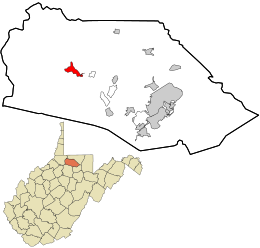Mannington, West Virginia
| Mannington, West Virginia | |
|---|---|
| City | |
 Location in Marion County and the state of West Virginia. |
|
| Coordinates: 39°31′38″N 80°20′23″W / 39.52722°N 80.33972°WCoordinates: 39°31′38″N 80°20′23″W / 39.52722°N 80.33972°W | |
| Country | United States |
| State | West Virginia |
| County | Marion |
| Area | |
| • Total | 1.15 sq mi (2.98 km2) |
| • Land | 1.10 sq mi (2.85 km2) |
| • Water | 0.05 sq mi (0.13 km2) |
| Elevation | 974 ft (297 m) |
| Population (2010) | |
| • Total | 2,063 |
| • Estimate (2012) | 2,070 |
| • Density | 1,875.5/sq mi (724.1/km2) |
| Time zone | Eastern (EST) (UTC-5) |
| • Summer (DST) | EDT (UTC-4) |
| ZIP code | 26582 |
| Area code(s) | 304 |
| FIPS code | 54-51100 |
| GNIS feature ID | 1542721 |
Mannington is a city in Marion County, West Virginia, United States located in the hills of North-Central West Virginia. Known as Mannington since 1856, the town is rich with history and heritage – from Native American relics to frontiersmen and their settlements to Civil War legends. Perhaps what makes Mannington most unusual is the impact of the oil and gas boom in 1890 that literally changed the shape of the town. The population was 2,063 at the 2010 census.
Mannington is located at 39°31′38″N 80°20′23″W / 39.52722°N 80.33972°W (39.527340, -80.339742), along Buffalo Creek.
According to the United States Census Bureau, the city has a total area of 1.15 square miles (2.98 km2), of which, 1.10 square miles (2.85 km2) is land and 0.05 square miles (0.13 km2) is water.
At the time of the first settlement, the west fork of Buffalo Creek was known as Warrior’s Fork, while the North Fork has historically borne the name of Pyle's Fork. One of the first settlers in the area was John Ice, who was born in the valley of the South Branch of the Potomac River in what was then Virginia. As a child, Ice and his father searched in vain for his mother, two sisters and brother who had been captured by the Indians. The mother was never found, although the children ultimately were. Only John's brother, known from then on as "Indian Billy" returned to the family. The sisters chose to remain with their one time captors (Prichard 1983).
Indian activity was not uncommon in the area and many settlers and travelers met their fate at the hands of the Indians, including John Madison, the cousin of James Madison the future president, who was killed on a surveying trip in the area in 1783. Although not necessarily as a result of this, James Madison did procure, as an investment, some land on Brush Run and Pyles Fork just north of Forks of Buffalo.
...
Wikipedia
